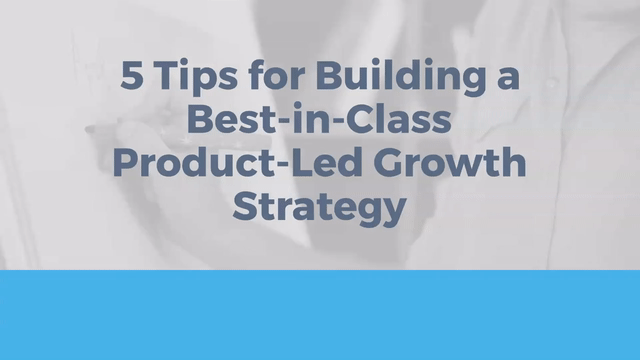Product-led growth (PLG) strategies are making waves in the SaaS industry—and that’s good news for SaaS product leaders and managers. By placing your product at the center of your growth strategy, your team can boost customer satisfaction, increase renewals, and lower acquisition costs.
Sound like a lot of work? It doesn’t have to be. We’ve picked out five tips to help you create a best-in-class product-led growth strategy quickly and easily.

What is a product-led growth strategy?
A product-led growth (PLG) strategy is a tactic that focuses on your product as the main growth driver. In a PLG model, you drive growth, revenue, and higher product usage by constantly enhancing your product. In SaaS, PLG models are becoming increasingly important. In fact, Forrester research found companies that use PLG strategies hold a median enterprise value that’s twice as high as the public SaaS index as a whole.
Ready to start perfecting your product and implementing a winning product-led strategy? Here are five tips to keep in mind:
1. Put customer experience first.
Positive customer experience is the fuel that ignites the best product-led growth strategies, and a focus on the user’s experience can open the floodgates to more revenue. In fact, a Dimension Data study found 84% of companies that place a focus on bettering the customer experience saw an uptick in revenue.
So, how can you anchor your PLG strategy in customer success? Go to the source: your users. Start by building feedback loops into your product, examining user surveys and sentiment analysis, and spotting the friction points in your product. With this feedback lighting the way, you’ll see a clear route to better user experiences and a more valuable product.
2. Master your product roadmap.
Another critical piece in driving product-led growth is charting a product roadmap that keeps your team on track to smash your goals. Your product roadmap will lay out a shared vision of what you want to accomplish with your product, enhancements you want to include, and the features you want to launch.
One of the simplest ways to craft a successful product roadmap is to let user data guide your plans. That means digging into user behaviors, surveys, and other storytellers about your product. This data will serve as the raw materials to build a plan that fits your users and addresses their needs.
3. Let data fuel your growth strategy.
Want to create a product that users love? Start by diving into what’s missing and what your current users already find irresistible. By digging into in-product metrics, you can spot those areas where your product is falling short of expectations.
At the same time, you can uncover—and replicate—those golden features that are hiding in your product. Here are a few important metrics that will be especially useful if you want to spark product growth:
- Net dollar retention (NDR)
- Net retention rate (NRR)
- Net Promoter Score (NPS)
- Time to value (TTV)
- Gross renewal rate (GRR)
- Retention cost
4. Focus on adoption and engagement.
To implement a successful product-led growth strategy, it’s not enough to create new features and drop them into your product. You need to lift adoption and keep users engaged.
One of the best ways to encourage more adoption is to incorporate in-app engagements into your product. By adding helpful in-product engagements, such as user guides or callout boxes, you show users how and why they should interact with new features. In turn, they’ll be more likely to use those features your team spent so much time developing. And they’ll have more reasons to keep logging into your product.
5. Relentlessly improve your product.
The best product-led growth strategies are constantly moving forward. By proactively improving your product and anticipating user needs, you’ll show your users you care about their experience—and that builds loyalty.
In order to consistently improve your product, take a hard look at your customer and user journeys. For instance, you can use path and funnel analysis to track the steps your users are taking as they travel through your product. Those insights will highlight what’s stopping users from picking up a feature as well as the additions you could make to keep them moving forward. From there, you can make product tweaks that positively impact the user’s experience and drive company growth.
Learn more about Product-Led Growth Strategy
Download our e-book, Product Led Success: The Professional’s Handbook for a look at how businesses are thinking about how to scale while improving customer experience to match rapid growth.

